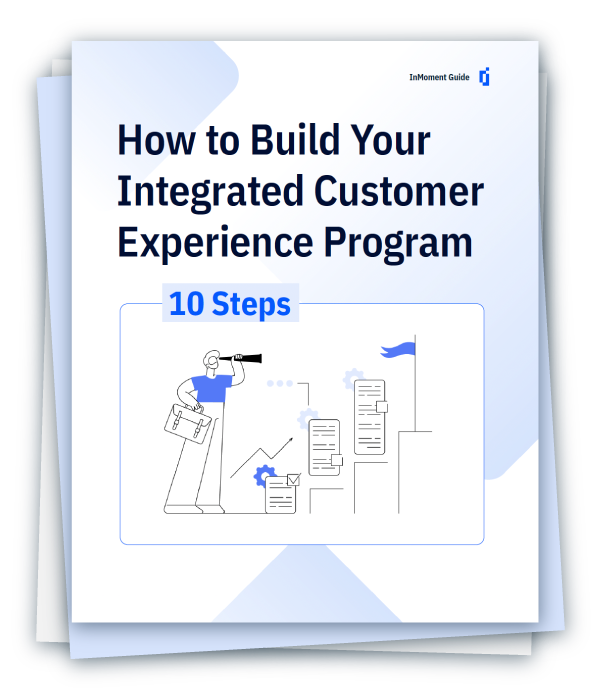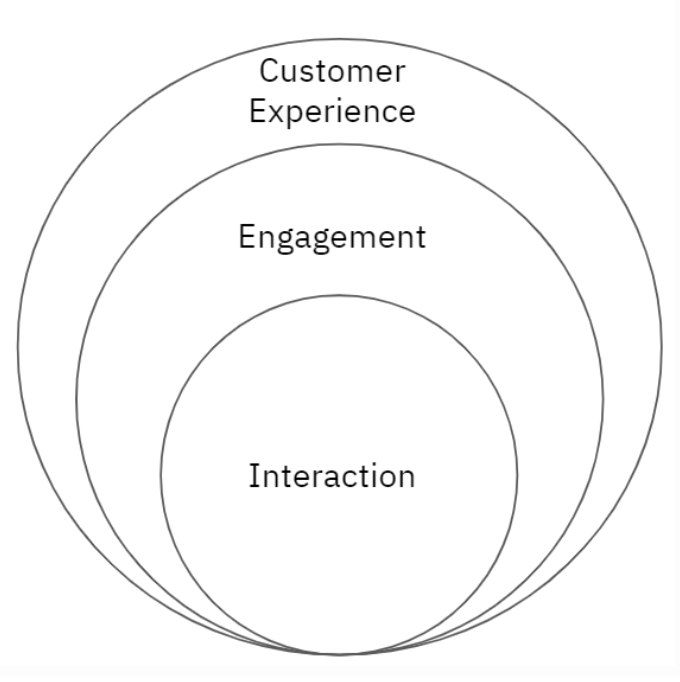The best customer experience quotes can be a great source of inspiration for leadership teams and entire organizations looking to drive their CX transformation. With customer experience management emerging as a key growth strategy for companies across a wide variety of industries, the importance of delivering great experiences cannot be understated.
According to research:
- Companies that earn $1 billion annually can expect to earn, on average, an additional $700 million within 3 years of investing in customer experience.
- Customer-centric companies are 60% more profitable than companies that don’t focus on customers.
For organizations of any size, managing CX can be a complex and challenging process that involves executive commitment, strategy, and integration of technology. Nevertheless, it’s an exciting and rewarding investment priority for any size and type of business. Elements of the process range from mapping the customer journey, deploying customer experience management software, and capturing customer feedback to tracking customer experience KPIs, developing service training programs, and launching strategic sales and outreach efforts.
In the spirit of helping teams adopt an integrated CX approach, we gathered some of the best quotes on customer experience: what it means, how rewarding it can be for brands, what it involves, and how to plan strategically. With the right approach and unwavering commitment, companies can foster a customer experience culture and deepen their relationships with customers, leading to increased loyalty, advocacy, and business success.
Customer Centric Quotes
The first set of quotes about customer experience highlights the importance of focusing on the customer.
While brands may be able to capture the interest of their audience with low prices, catchy slogans and marketing visuals, compelling sales pitches, or savvy social media campaigns, the ultimate differentiator is superior customer experience.
“We see our customers as invited guests to a party, and we are the hosts. It’s our job every day to make every important aspect of the customer experience a little bit better.” (Jeff Bezos, founder and executive chairman of Amazon)
This Jeff Bezos quote means that the company views its customers as valued guests, much like attendees at a party. As hosts of this “party,” the company is responsible for ensuring that every aspect of the customer experience is enjoyable and satisfactory.
After all, now more than ever, consumers rate and judge businesses not by the quality or price of their products and services, but by the experience the business builds around these products and services. This involves continuously striving to improve all elements of the customer experience, whether it’s the quality of products or services, the level of customer service provided, the ease of doing business with the company, or any other aspect that impacts the customer’s interaction with the brand.
Once your entire organization understands and acts on this customer experience quote, you’ll be in a great position to attract customers and keep them coming back.
“Make a customer, not a sale.”
This old business adage is one of the best customer experience quotes for any company. Some companies are focused only on making the sale but don’t pay nearly enough attention to satisfying customers’ wants and needs. To truly drive growth, companies must manage the entire customer experience and offer next-level support. Doing so can lead to transcendental customer-company relationships, which are essential to building customer loyalty and improving customer satisfaction.
“If you’re not serving the customer, your job is to be serving someone who is.” (Jan Carlzon, founder and former CEO of SAS Group)
Customer experience is a core value that should involve everyone in your organization, from the C-suite to the frontline. Every team or department, from marketing and sales to customer support and product development, has a stake in the customer experience.
This statement by Jan Carlzon emphasizes the importance of customer focus and service within an organization. It suggests that if an individual’s role or responsibilities do not directly involve serving the customer, then their primary responsibility should be supporting those who are directly serving customers.
In other words, every member of an organization, regardless of their specific job title or function, should ultimately contribute to the overall goal of delivering great customer experiences. Whether it’s providing internal support, resources, or assistance to frontline employees who interact directly with customers, the entire organization should be aligned with this customer-centric mindset and respond to the needs and expectations of customers.
Quotes About Customer Experience and Brand Reputation
The next set of quotes describes the connection between customer experience and brand reputation.
A positive customer experience enhances the brand’s reputation, fosters trust and loyalty, stimulates positive word-of-mouth, shapes brand image and perception, and contributes to competitive differentiation. Conversely, negative customer experiences can damage the brand’s reputation, erode trust, and impact long-term success. Companies must therefore prioritize delivering exceptional customer experiences to strengthen their brand reputation management and build lasting relationships with customers.
“Courteous treatment will make a customer a walking advertisement.” (James Cash Penney, founder of JC Penney Stores)
One of the best customer experience quotes highlights how great experiences can lead to customers becoming advocates or promoters of your brand.
It’s important to note that the customer experience isn’t just about the way you develop your products and deliver your services. It’s also about the way you treat your customers. If your frontline employees are unkind, uncaring, and unresponsive, there is no way customers will engage with your business beyond the initial interaction.
Treating customers right, on the other hand, drives loyalty, strengthens your brand reputation, and engenders positive word of mouth. These satisfied customers who have been treated courteously can become powerful ambassadors for the company, effectively spreading positive word of mouth and contributing to your brand reputation and success.
“It takes 20 years to build a reputation and five minutes to ruin it. If you think about that, you’ll do things differently.” (Warren Buffett, American businessman and co-founder of Berkshire Hathaway)
This customer experience quote by Warren Buffett captures how your brand reputation (as shaped by customer feedback, online reviews, and social media comments) can make or break your business. It highlights the importance of online reputation management and the type of impact it has on customer experience.
With consumers no longer reliant on branded content to guide their purchase decisions, companies must stay on top of customer feedback and engage in conversations where their brand reputation is on the line. The quote also encourages brands to recognize the value of their reputation and the impact that their actions can have on it. By understanding the potential consequences of their decisions, they are more likely to approach their actions and behaviors with caution, integrity, and a long-term customer-focused perspective.
“The more advocates you have, the fewer ads you have to buy.” (Dharmesh Shah, co-founder and CTO of HubSpot)
Successfully managing the customer experience yields powerful benefits for businesses. This customer experience quote by Dharmesh Shah highlights the power of brand advocacy and word-of-mouth marketing in reducing the need for traditional advertising. When your company delights customers, you are effectively building a strong base of advocates: satisfied customers who will actively promote the brand to others and spread positive word of mouth about your products or services.
By cultivating a loyal customer base and providing exceptional experiences that inspire advocacy, you can significantly reduce customer acquisition and retention costs while still achieving strong growth.
Quotes About Customer Experience and Leadership
The following quotes about customer experience touch on the role that leadership plays as companies look to become truly proactive and intuitive, see through customers’ eyes, and better understand their needs, wants, and expectations.
“Building a good customer experience does not happen by accident. It happens by design.” (Clare Muscutt, founder of Women in CX)
One of the best customer experience quotes talks about the importance of intentional planning and effort in creating a positive customer experience. It suggests that creating a good customer experience requires executive commitment as well as deliberate actions and strategies, rather than simply relying on chance or luck. In other words, businesses must actively design and implement processes, policies, and interactions with customers to ensure a satisfying and enjoyable experience for them.
“If people believe they share values with a company, they will stay loyal to the brand.” (Howard Schultz, former chair and CEO of Starbucks)
Great customer experience involves listening to your customers and creating a relationship in which they feel heard and valued. When they feel they have an emotional connection with your brand and believe they share values with your company, they will show loyalty and consistently choose you over competitors.
This also underscores the significance of authenticity and consistency in brand messaging and behavior, as they contribute to fostering a deeper connection and sense of trust between a company and its customers. When customers feel a strong alignment between their own personal values and the values espoused by a company, they are more likely to develop a sense of loyalty to that brand.
“My advice is to answer every customer, in every channel, every time. This is different from how most businesses interact with customers, especially online, which is to answer some complaints, in some channels, some of the time.” (Jay Baer, author and founder of Convince and Convert)
This quote highlights the importance of consistently and comprehensively addressing customer inquiries, feedback, and complaints across all communication channels. It suggests that companies should prioritize responsiveness and engagement with customers regardless of the platform or channel they choose to communicate on.
For example, if a customer wrote a 5-star review or gave your business a nice compliment via email, take the time to say thank you. If the feedback is negative or the review came with a low rating, acknowledge the customer and work on resolving any issues related to their experience.
This customer experience quote also touches on the importance of local listings management. By claiming ownership of specific pages on online channels where your brand is present, you can more easily listen and respond to existing and potential customers. On most directories where you have claimed listings, you’ll be able to present yourself as a representative of your company, answer questions and queries, and learn how to respond to negative reviews as well as positive feedback.
By committing to answering every customer, in every channel, every time, brands can provide attentive and personalized customer support, which can enhance customer satisfaction, build trust, and foster long-term loyalty.
“Pay attention to the way you talk about the work you’re doing. If you design for people, use people language.” (Julie Zhuo, businesswoman and former VP of design for Facebook)
Another important aspect of managing the customer experience is tailoring your messaging and communications so that the voice of your brand speaks the language of your customers. When designing products, services, or experiences for your users and customers, it’s important to use language that resonates with and is easily understood by the audience you are designing for.
By doing so, you can more effectively connect with your audience, convey the benefits and value of your work, and ultimately create solutions that meet the needs and preferences of your customers.
Quotes About Customer Experience and the Importance of Customer Feedback
Some of the best quotes on customer experience talk about the powerful role that customer feedback plays in CX improvement. Using information from customer feedback, companies can gain valuable insights essential to improving their brand, products, services, and overall customer experience. Organizations that can monitor and manage customer feedback also often have a more complete understanding of their customers, and can easily measure customer satisfaction and loyalty. Valuable sources of customer feedback include:
- Customer feedback and customer satisfaction surveys
- Call center transcripts, emails, and phone calls
- Online reviews and ratings
- Social media comments
- Individual customer interviews and roundtables
- Usability tests
The most successful companies listen to and act on feedback to understand customers better and deliver improved customer experiences. Through feedback, companies get to hear customers’ stories and experiences through their own words and from their own perspective.
“I like to listen. I have learned a great deal from listening carefully. Most people never listen.” (Ernest Hemingway)
Many companies develop their marketing strategies around the many ways they can push branded content, sales messages, and promotional content to consumers. However, success in managing the customer experience is founded on a company’s ability to listen.
Companies should listen in real-time to customers across multiple touchpoints and channels, as well as provide immediate responses to customer feedback. A Voice of the Customer program should help organizations listen in to every customer and every conversation at various stages of the customer journey — not to mention, dig deeper into data on both macro and micro levels.
“A brand is no longer what we tell the consumer it is. It is what consumers tell each other it is.” (Scott D. Cook, founder of Intuit, former founder of eBay)
This quote encapsulates the shift in the dynamics of branding and marketing brought about by the rise of social media and digital communication. Previously, companies could control their brand reputation through advertising, messaging, and other promotional efforts. However, with the emergence of social media and online reviews, consumers now have a significant influence on shaping a brand’s reputation, and their expectations of the customer experience are based on how a brand is perceived online, where companies are defined by the collective perceptions, opinions, and experiences shared by consumers with each other.
This means that your team should prioritize customer satisfaction, engage with your audience authentically, and deliver exceptional experiences, as these factors directly impact how consumers perceive and discuss the brand. Ultimately, your brand reputation is shaped by the conversations and interactions happening among consumers, making it crucial to actively manage and nurture your reputation in the eyes of your customers.
“Get closer than ever to your customers. So close that you tell them what they need well before they realize it themselves.” (Steve Jobs, founder of Apple)
Before you can attempt to understand and improve the customer experience, you have to be able to know who your customers are. This is the first step to achieving true customer centricity.
Some of the ways you can get closer to your customers is to capture feedback and Voice of the Customer data as well as map the customer journey. Doing so enables you to gain a deeper understanding of customers’ needs, motivations, and behaviors, allowing you to anticipate future needs and deliver more personalized and proactive experiences.
Knowing your customers also means being able to identify potential pain points or areas of frustration that they may encounter during their interactions. Anticipating these pain points allows you to proactively address them, ensuring a smoother and more satisfying experience for customers.
“Your most unhappy customers are your greatest source of learning.” (Bill Gates, co-founder of Microsoft)
Negative reviews and social media comments can hurt like a gut punch, but this type of feedback can be beneficial for organizations looking to improve the customer experience. Negative feedback is a rich source of insights into areas for improvement, opportunities for innovation, and strategies for enhancing customer satisfaction and loyalty. By listening to and learning from negative feedback, you can strengthen your relationships with customers and drive long-term success.
Feedback from unhappy customers can also shed light on discrepancies between customer expectations and the actual experience you’re providing. By understanding these gaps, businesses can adjust their offerings, communications, and processes to better align with customer expectations.
“Don’t waste customers’ time asking them questions unless you are prepared to act on what they say.” (Bruce Temkin, co-founder of Customer Experience Professionals Association)
Capturing data is one thing; extracting insights from it is another. Beyond simply collecting data, companies can leverage tools like Voice of the Customer programs, predictive customer analytics, and customer feedback systems to ensure they are really hearing their customers and extracting rich, meaningful insights from their feedback.
A good mix of both quantitative and qualitative information will help drive action and business decisions. Reviews, star ratings, and satisfaction scores are obvious quantitative measures that you can start with. But you can also dive into the entire anatomy of these reviews with natural language processing technology and customer experience analytics, which help users determine and understand qualitative information like customer sentiment, emotion, and mood.
“Whatever you do, do it well. Do it so well that when people see you do it, they will want to come back and see you do it again, and they will want to bring others and show them how well you do what you do.” (Walt Disney)
This quote by Walt Disney emphasizes the importance of consistently delivering great customer experiences. The world’s most customer-centric companies are usually able to deliver experiences that inspire customers to become advocates for the brand, eager to return themselves and also to bring others along.
This means that every interaction with a customer should be performed to the highest standard possible; doing so not only helps build customer loyalty but also increases the likelihood of loyal customers sharing their positive experiences with others.
Kickstart Your Customer Experience Transformation with Pearl-Plaza
Pearl-Plaza, the leader in improving experiences and the most recommended CX platform and services company in the world, can help kickstart your company’s CX transformation. Pearl-Plaza’s all-in-one CX platform helps you collect, integrate, understand, and intelligently act on every signal, so that you can elevate customer experiences and achieve the greatest return from your CX program.


















